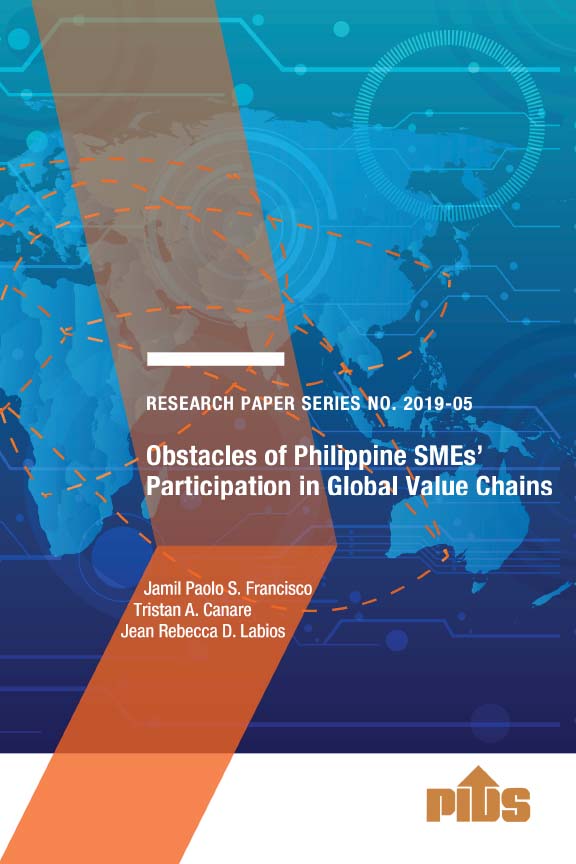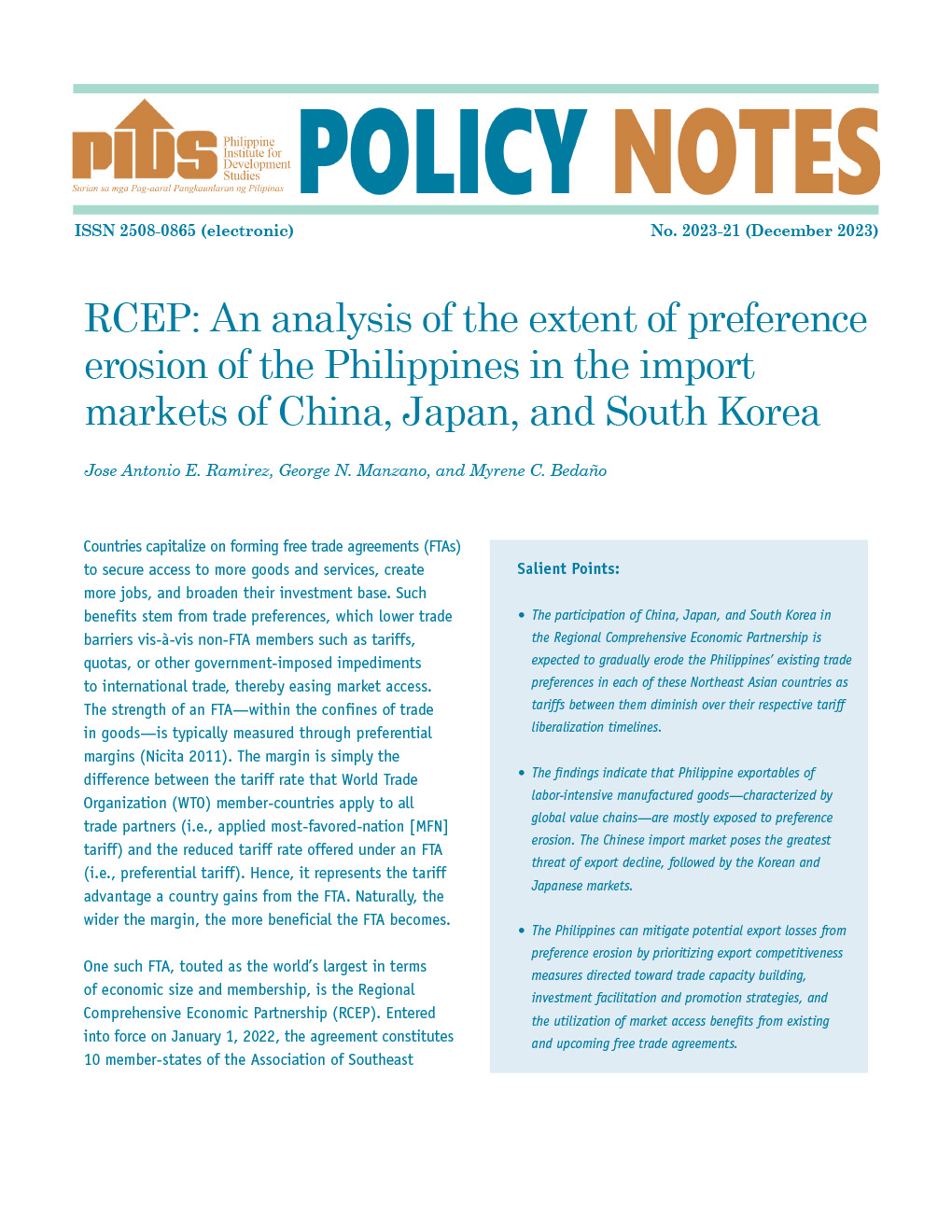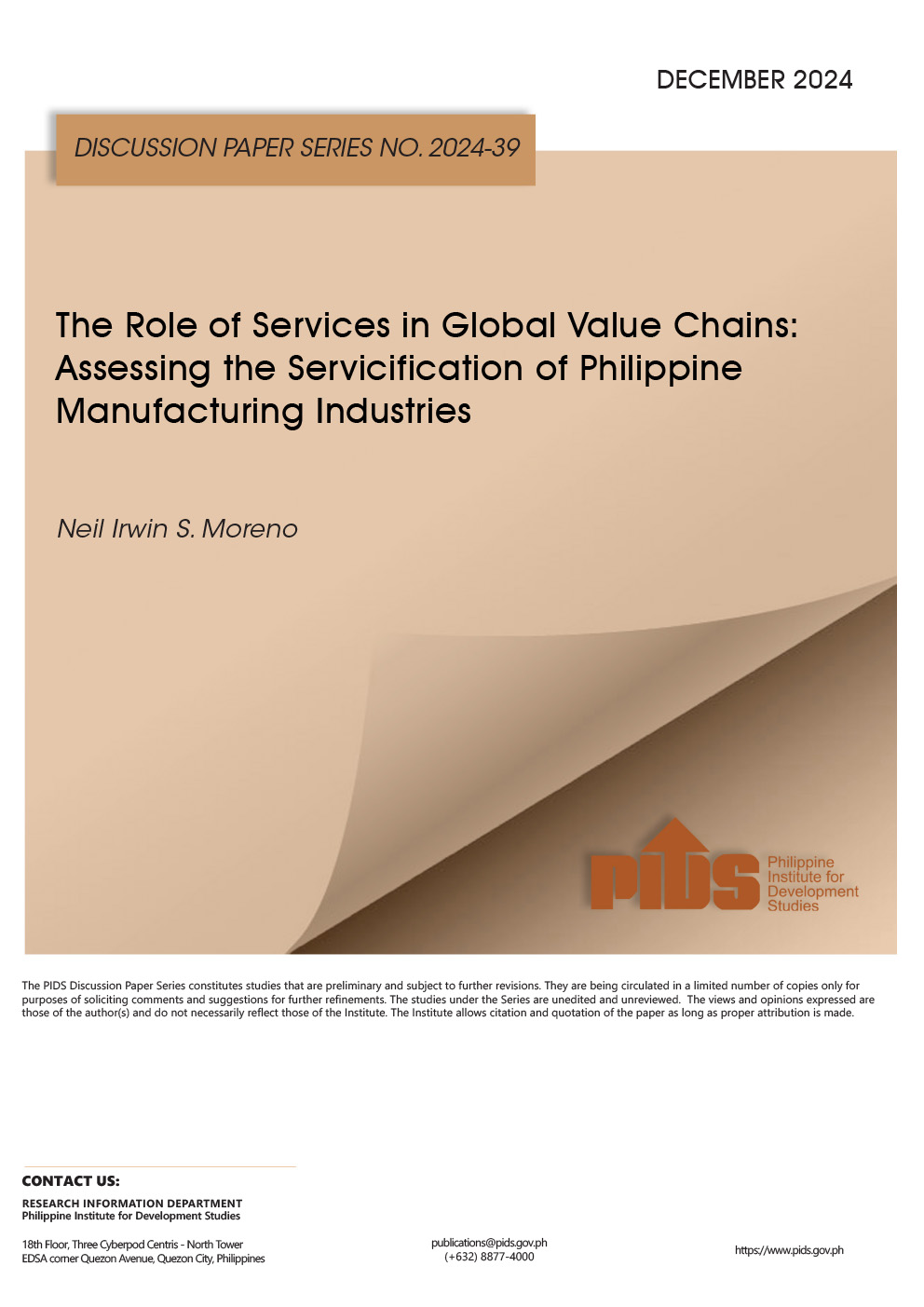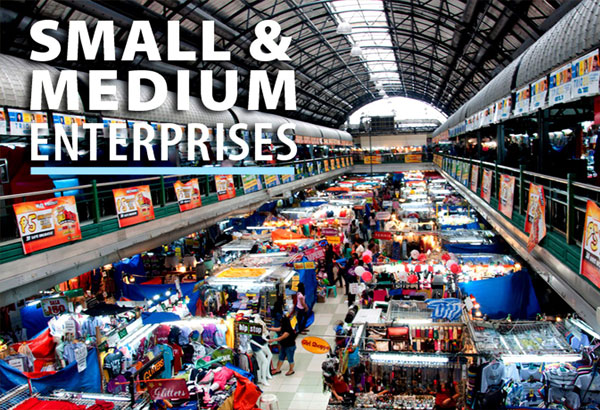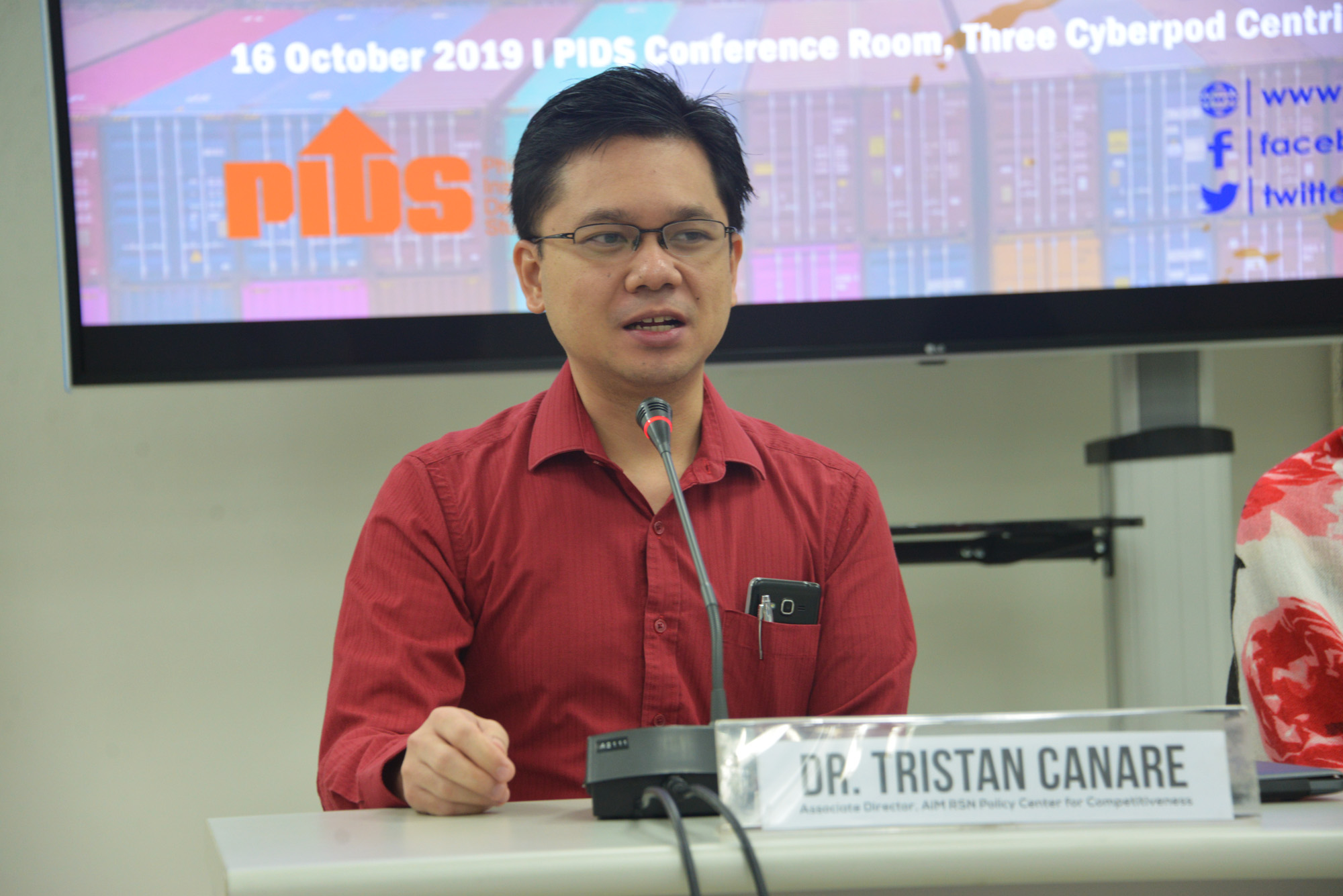
Only a few small and medium enterprises (SMEs) in the Philippines are linked to the so-called global value chains (GVCs). This is according to Philippine Institute for Development Studies (PIDS) Consultant Tristan Canare in a public seminar recently organized by the Institute.
GVCs, as defined by the World Economic Forum, are the “full range of activities undertaken to bring a product or service from its conception to its end use, distributed across international borders”.
In his presentation, Canare said it is important to link SMEs to GVCs to expand the country’s market access and promote the transfer of technology, human capital, and information.
SMEs account for 99.5 percent of the total registered firms in the Philippines or almost two thirds of the total sectoral employment and contribute a third of the gross value added to the economy.
Citing the result of the research paper “Obstacles and Enablers of Philippine SMEs Participation in Global Value Chains”, which he coauthored with Jamil Paolo Francisco and Jean Rebecca Labios, Canare said the ‘weak connection’ between Philippine SMEs and GVCs can be attributed to some ‘perceived obstacles’, such as the country’s high tariff taxes in export markets, issues on corruption, and foreign currency fluctuations, among others.
The study also found several challenges to Philippine SMEs’ participation in GVCs. For instance, they have difficulty competing with their counterparts in Southeast and East Asia because they lack the ability to scale up production, thus missing out on economies of scale. “They are too small and not well organized that if a bulk order would come, sometimes they have to say ‘no’. By not being able to mass produce, [they] will not only miss out markets but also [the chance to achieve] economies of scale,” Canare said.
Aside from this, many Philippine SME exporters are also in the “lower-value” part of the chain, meaning, they only export raw materials that are much cheaper than processed products. “For example, coconut is one of our main exports but we only export raw coconuts. The same goes with minerals in the mining industry,” Canare pointed out.
Philippine SMEs also find it hard to comply with international standards and regulatory requirements. “Most export markets require certain certifications and standards for products before you can export to those markets. Applying for these certifications could be very expensive. Sometimes you need to acquire some technologies and equipment which are costly. Most SMEs do not have the capital for this,” Canare explained.
The perennial problem on inefficiencies in processing permits and licenses, and in customs and ports operations in the country also make it more difficult and costlier to export products.
Many Philippine SMEs also fail to adopt to changing market conditions and consumer preferences in export market in terms of international market demand and inputs supply. “One reason for this is that our SMEs that export their technology and assets have high asset specificity, meaning, they cannot just change or adjust their products [anytime] because their technologies and equipment are designed to produce only certain products, meaning, the machine used in producing cotton clothes is different from the machine used to produce wool clothes,” Canare explained.
Many SMEs in the Philippines also lack market information. “They don’t know which export market to penetrate because they lack access to information on the demand of consumers. Sometimes they also experience problems in accessing inputs including skilled labor,” Canare noted.
He also pointed out that most Philippine SMEs do not have entrepreneurial mindset and skills. “They are risk-averse. But we have to understand why they are risk-averse. One possible reason for this is the lack of social protection. They do not have many assets, or a fallback or a safety net in case an investment produces negative returns so they are reluctant to invest in something that is new and unfamiliar,” Canare said.
Among the recommendations of Canare and his coauthors to address these issues and gaps is to enhance the efficiency of ports and customs operations by simplifying processes through automation, improve credit terms of SME loans by offering longer repayments, incentivize export of higher value products rather than raw materials in the form of tax breaks, implement programs to promote linkages between SMEs and foreign or large firms, expand their entrepreneurial skills training, find new market niches where competition is not yet too tough, and avoid the procurement of equipment with high asset specificity or those machines that can only produce one product.
They also encouraged SMEs to engage in indirect export which may be done through consolidators or a third party that buys export quality products from local producers and selling them in countries where there is demand, as well as take advantage of government support and network such as Negosyo Centers and the Kapatid Mentor Me Program to improve their entrepreneurial abilities. ###
GVCs, as defined by the World Economic Forum, are the “full range of activities undertaken to bring a product or service from its conception to its end use, distributed across international borders”.
In his presentation, Canare said it is important to link SMEs to GVCs to expand the country’s market access and promote the transfer of technology, human capital, and information.
SMEs account for 99.5 percent of the total registered firms in the Philippines or almost two thirds of the total sectoral employment and contribute a third of the gross value added to the economy.
Citing the result of the research paper “Obstacles and Enablers of Philippine SMEs Participation in Global Value Chains”, which he coauthored with Jamil Paolo Francisco and Jean Rebecca Labios, Canare said the ‘weak connection’ between Philippine SMEs and GVCs can be attributed to some ‘perceived obstacles’, such as the country’s high tariff taxes in export markets, issues on corruption, and foreign currency fluctuations, among others.
The study also found several challenges to Philippine SMEs’ participation in GVCs. For instance, they have difficulty competing with their counterparts in Southeast and East Asia because they lack the ability to scale up production, thus missing out on economies of scale. “They are too small and not well organized that if a bulk order would come, sometimes they have to say ‘no’. By not being able to mass produce, [they] will not only miss out markets but also [the chance to achieve] economies of scale,” Canare said.
Aside from this, many Philippine SME exporters are also in the “lower-value” part of the chain, meaning, they only export raw materials that are much cheaper than processed products. “For example, coconut is one of our main exports but we only export raw coconuts. The same goes with minerals in the mining industry,” Canare pointed out.
Philippine SMEs also find it hard to comply with international standards and regulatory requirements. “Most export markets require certain certifications and standards for products before you can export to those markets. Applying for these certifications could be very expensive. Sometimes you need to acquire some technologies and equipment which are costly. Most SMEs do not have the capital for this,” Canare explained.
The perennial problem on inefficiencies in processing permits and licenses, and in customs and ports operations in the country also make it more difficult and costlier to export products.
Many Philippine SMEs also fail to adopt to changing market conditions and consumer preferences in export market in terms of international market demand and inputs supply. “One reason for this is that our SMEs that export their technology and assets have high asset specificity, meaning, they cannot just change or adjust their products [anytime] because their technologies and equipment are designed to produce only certain products, meaning, the machine used in producing cotton clothes is different from the machine used to produce wool clothes,” Canare explained.
Many SMEs in the Philippines also lack market information. “They don’t know which export market to penetrate because they lack access to information on the demand of consumers. Sometimes they also experience problems in accessing inputs including skilled labor,” Canare noted.
He also pointed out that most Philippine SMEs do not have entrepreneurial mindset and skills. “They are risk-averse. But we have to understand why they are risk-averse. One possible reason for this is the lack of social protection. They do not have many assets, or a fallback or a safety net in case an investment produces negative returns so they are reluctant to invest in something that is new and unfamiliar,” Canare said.
Among the recommendations of Canare and his coauthors to address these issues and gaps is to enhance the efficiency of ports and customs operations by simplifying processes through automation, improve credit terms of SME loans by offering longer repayments, incentivize export of higher value products rather than raw materials in the form of tax breaks, implement programs to promote linkages between SMEs and foreign or large firms, expand their entrepreneurial skills training, find new market niches where competition is not yet too tough, and avoid the procurement of equipment with high asset specificity or those machines that can only produce one product.
They also encouraged SMEs to engage in indirect export which may be done through consolidators or a third party that buys export quality products from local producers and selling them in countries where there is demand, as well as take advantage of government support and network such as Negosyo Centers and the Kapatid Mentor Me Program to improve their entrepreneurial abilities. ###

